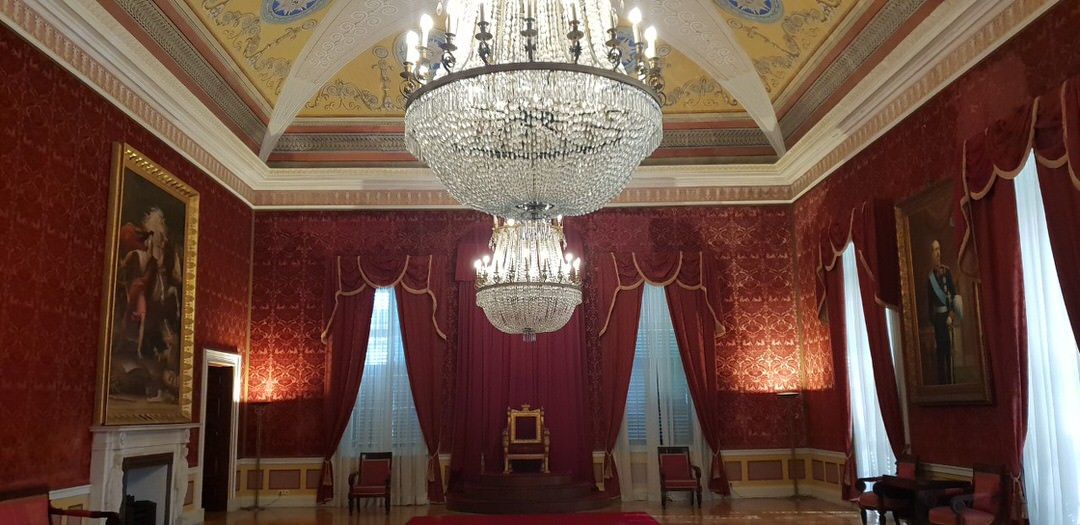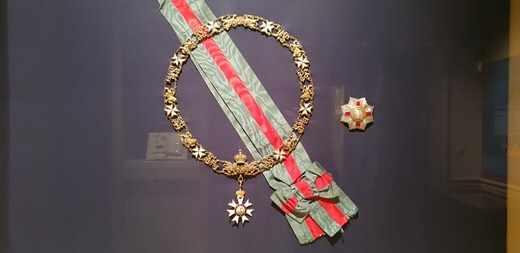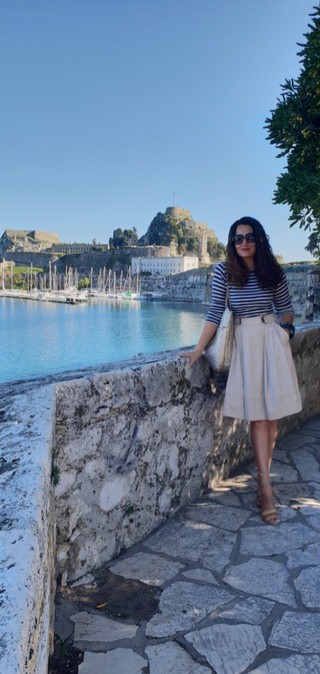All visitors of Corfu know that a large part of its unique character as an amalgam of different cultures, is attributed to the succeeded occupation of different nations, starting with the Venetian domination that lasted for 4 centuries. Then, Corfu passed into French occupation for nearly 15 years and then came the British military administration that lasted 50 years, until the island’s unification with modern Greece.
The British presence had a large impact in the Corfian culture and everyday life, as Corfu was the center of the British interests among Ionian Islands. The British mark was evident in a new transport network, in the design of the water supply system, in agriculture and education. In architecture in particular, new grand scale buildings brought to the old town of Corfu a combination of British Georgian and Greek Neoclassical style. But how is a British monumental palace interrelated with Asian art and what does this mean for Corfu of modern era?
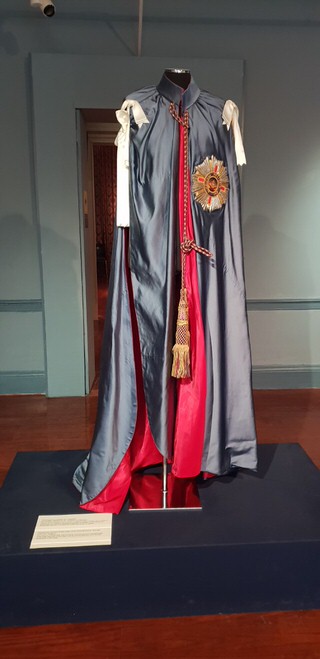
The history of the magnificent palace of St Michael and St George starts in early 18th century with Sir Thomas Maitland, the 1st British High Commissioner in Corfu, who decided that the Old Fortress’ building where he lived, wasn’t imposing and large enough and so, requested a new residence to be built in the northern part of Esplanade square. The creation of the Order of Saints Michael and George, that was founded in England and based in Corfu, provided the formal reason for the construction of a palace that would also serve as the order’s seat. The foundation stone was laid on the day of St George’s celebrations in 1819 and the location chosen by Maitland, so close to the Venetian fortress and the sea, added to the splendor of the project.
George Whitmore who made the designs, was a British member of The Royal Engineers, who was serving in Corfu under Maitland’s command as a sublieutenant. Perhaps the fact that he had also served in Malta before, influenced him in choosing Maltese limestone for the construction of the palace and bringing workers from Malta to be occupied on the project. By 1824 the majestic building was completed. The Regency style – the late phase of Georgian architecture – elegantly integrates a long line of Doric columns, that form a colonnade in the front side, with two symmetrical, apsed gates, those of St Michael and st George. You can also admire a series of sculptured depictions of the Ionian islands in the facade’s fringe.
As you walk inside the two-stores palace, you witness the grandeur continuing in the interior, underlined by the use of marble and bronze. The central chamber is surrounded by double rows of Ionian pillars and decorated with scenes from the Odyssey. The ground floor is where periodic exhibitions are held today. Consider yourself particularly lucky if during your visit, heirlooms of the history of the Order of St Michael and St George are on display. In this case you will be able to observe original attire like the silk cape and a silver morse for the High Priest of the Order, insignia, medals and paintings, along with detailed information about the history and the importance of the Order.
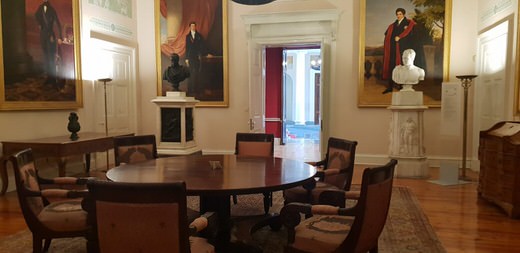
However, the most important exhibit on the ground floor is the room where the Ionian Senate used to convene, as the palace was also the Senate’s seat. The six member Ionian Senate was the government of the united state of the Ionian islands and together with the Ionian Parliament constituted the symbols of the Ionian island’s autonomy. Its presidents and many of its senates were even granted the title of the knight of the Order of St Michael and St George. The original furnishing of the chamber remains, with the six-seat rotunda table and the portraits of distinguished senate members on the walls.
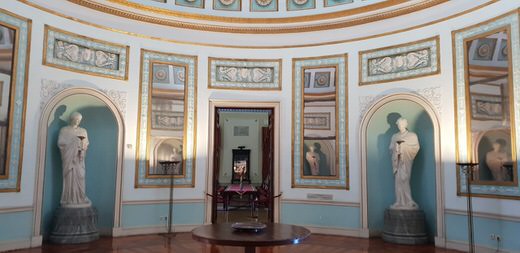
Leaving the ground floor, a grand staircase will lead you on the first floor, where the decorative style changes and adopts Corinthian style columns. We are now in the most impressive part of the palace, where the official rooms once pulsed with life. The three official halls are one more impressive than the other. The central one, the circular Ball Room, is a graceful space, painted in light blue, adorned with mirrors and niches with statues and crowned with a dome that resembles that of Roman Pantheon with its single, round window that allows the bright Corfian sunlight in.

The Ball Room leads to the other two rooms, the State Dining Room and the Throne Room. In the State Dining Room its the drawn ceiling that draws attention, while the Throne Room with the large, crystal chandeliers, the crimson wall papers, heavy curtains and carpet, the large royal portraits and of course the throne on a wooden pedestal, is definitely the most impressive hall. Worth mentioning is the fact that all furniture was designed by the building’s architect, George Whitmore, while a local artist and excellent sculptor, Pavlos Prosalentis , worked closely with Whitmore and was responsible for the entire sculpting decoration of the palace.
Sadly for Maitland, but to the benefit of Corfians who resented his authoritarian, imperious and disparaging attitude, never lived in the palace as he was succeeded by Sir Frederick Adam, the new British Lord High Commissioner of the Ionian Islands. He showed great love and interest in Corfu, commissioned the construction of public buildings, improved the water supply system and even married the local lady Nina Diamantini. His work was much appreciated by people of Corfu and it’s his statue – again by Pavlos Prosalentis – that now stands in the front garden of the palace.
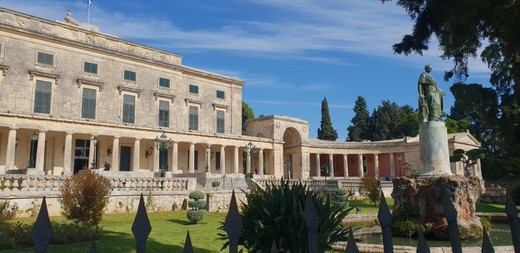
“Sir Frederick Adam’s great love and interest in Corfu was much appreciated by the people of the island and it’s his statue that today decorates the front garden of the palace…”
The palace kept its role as a royal residence even after the unification of the Ionian islands with the Greek state in 1864. The severe damage it suffered during World War II and especially during its use as a temporary refugee shelter during the Greek Civil War, was restored in 1954, mainly thanks to a private trust that was organised by Sir Charles Peake, British Ambassador in Greece. The three state halls regained their appeal and glamour and the palace was used once more by Greece’s last king, Konstantinos, on state occasions during the time he was temporarily staying at nearby villa, Mon Repos, that was originally built by Frederick Adam.
Today the palace houses an extraordinary collection of no less than 11.000 objects of Far East art, which answers the question of how is a British monumental palace interrelated with Asian art. The Museum of Asian Art is unique in Greece and covers almost all aspects of eastern culture, including works of art that are characteristic of the Chinese, Japanese, Thai, Corean, Pakistani and Indian culture. Furthermore, one of the palace’s wings is home to the Municipal Gallery of Corfu, that hosts a very interesting collection of paintings by local artists.
The graceful and serene setting is completed by the beautiful gardens that once belonged to the palace, but now form a public park know as The People’s Garden. Filled with flowers, exotic trees, statues and works of contemporary art, it’s one of the most idyllic and picturesque places in the old town of Corfu, offering breathtaking, panoramic views towards the Venetian old fortress and the small island of Vido. And if you happen to see swimmers on the bay right under the garden, well, the descending way to sea is only a few minutes away and the bright blue Ionian waters are waiting for you. Afterall, it’s what the former Greek royal family used to do, when staying at the palace.

